The 11 Best Customer Feedback Tools for 2026
In this article we’re going to lay out exactly why you need to invest in a great feedback tool in 2026, and give a brief overview of 12 solid choices.
First things first, what’s the value of a feedback tool?
Feedback matters - a lot
How do you gather user feedback now? The businesses that lag the furthest behind still rely on outdated models, thinking that giving a phone and email contact is enough.
Businesses that are more up with the times collect feedback from an array of forms, surveys, customer meetings and panels. Feedback also flows in through support tickets and is logged and processed by support and sales teams.
There’s quite a bit of friction involved in sending in an email, calling, filling out annoying forms, or sending a message through social media. It’s likely that the majority of people sufficiently motivated to do so will be reacting to negative experiences.
Then - what happens? Someone from the company gives some assurances, the issue gets escalated, the customer is thanked, then maybe the problem is dealt with. There will be a sea of requests, complaints, and suggestions building up - and the really important ones can get drowned out in the noise.
This is far better than nothing, but isn’t optimal. It isn’t enough to really bring users into the product development process, understand their needs on a deep level, get their best ideas, and build a community around your products.
Why you need a Feedback Tool
You need something better. One tool to gather, process, and action feedback from start to finish. You need a proper feedback tool.
Giving feedback the proper priority is key for several reasons:
- Some of the best product ideas and insights come from users themselves
- Users need to feel listened to and valued to become loyal and engaged
- Understand the user experience from the perspective of actual users
- Gain a reputation as a brand that puts the user first
To pull it off optimally, and become a truly user-centric brand, you need help. Feedback tools that are built specifically to help you to gather and process feedback - as well as prioritizing and actioning it.
We have compiled a list of the 10 top feedback tools in 2026. Read through them and decide which works best for you.
1. FeedBear
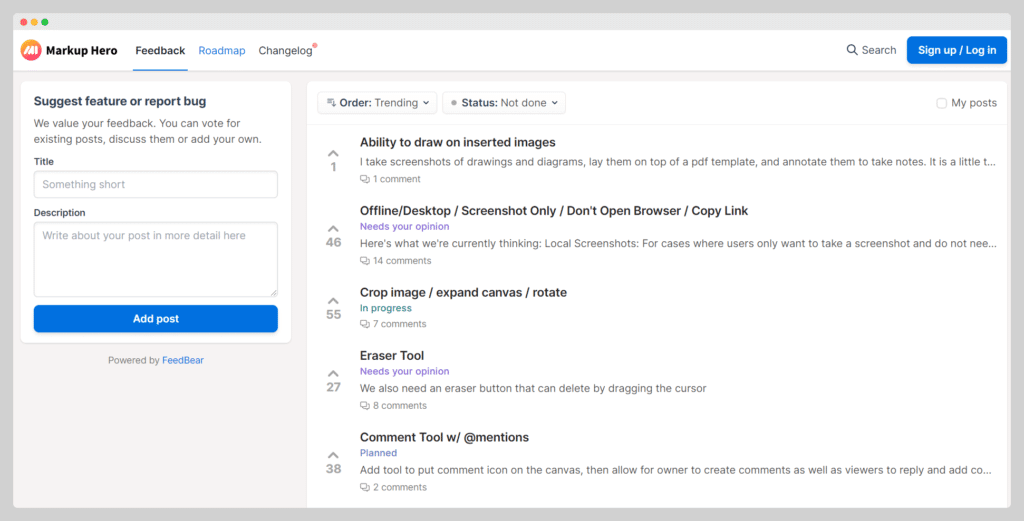
FeedBear is one of the best feedback tools on the market. When you start using FeedBear, you get a feedback board on your own domain and a site widget that makes it easy for users to share.
After an item is posted on the feedback board, other users can interact with it too by commenting and upvoting - giving you a wealth of data on which to make decisions.
You and your team can also be active on the board, asking follow questions and clarifying things for users.
The feedback board is just one part of FeedBear though. When you decide to act on an update, bug fix, or new feature - you’ll assign it a status like:
- Needs your opinion
- In progress
- Planned
When you do this it will trigger automatic email updates to any users who engaged with the item by contributing, commenting or upvoting.
The feedback item will stay on the feedback board, but it will also be moved to the product roadmap.
The roadmap gives users and stakeholders a single destination to see exactly what you’re working on and what they can expect from your product in the near future. It’s also completely integrated with the Feedback Board. Users can click a roadmap card, and they’ll be taken right back to the feedback board where they can see the context around the initiative, view the comment history, vote and add to the discussion themselves.
Finally FeedBear gives you a Changelog, where you can share all the updates and product improvements that you’ve shipped. The Changelog is one destination to share your achievements, and shows the world that you are actively improving and refining your product constantly.
FeedBear is more than just a feedback tool, like some of the others in this list - it’s a product management tool that takes user feedback as its primary input. It creates a whole “feedback loop” that puts users at the center of your product and brings them closer to you and your team.
Pricing: $29/m for unlimited users and boards
Verdict: An excellent choice, great value for money, perfect for SaaS businesses and startups. We know the tool well, some of us are working on developing FeedBear and use it daily.
2. Canny
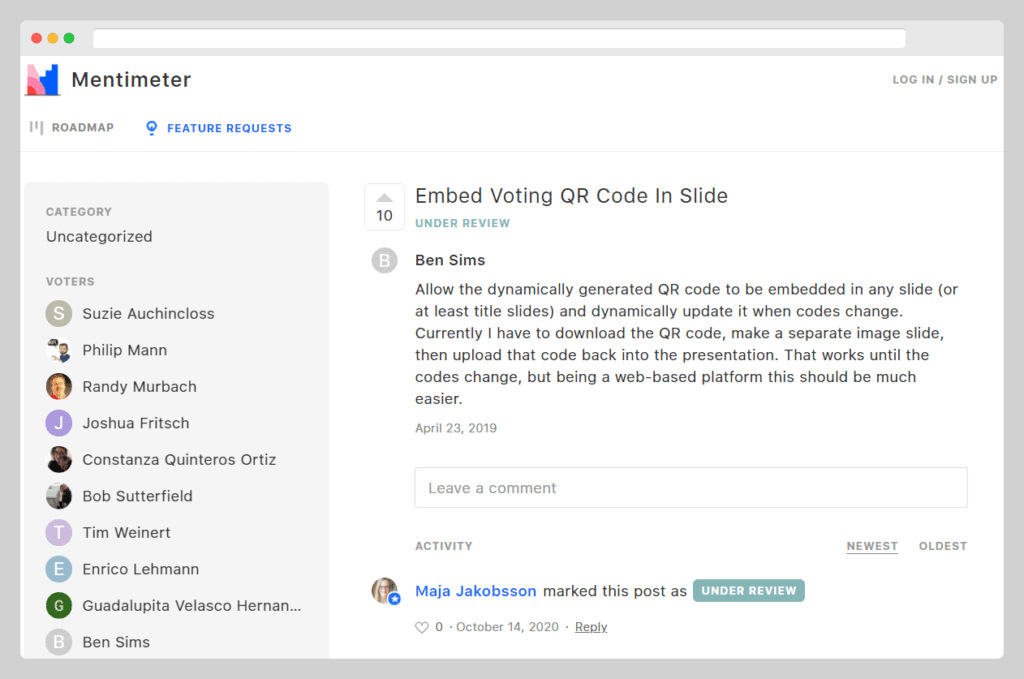
Canny is another feedback tool similar to FeedBear. It also gives you a well-designed feedback board, a roadmap, and a changelog - with a helpful suite of features and tools to help you with product management.
Canny is different from FeedBear in a few ways. Both have some features that the other lacks.
In general, Canny is arguably more complex and suited to users further toward the enterprise end of the spectrum. Feedbear is more suitable for startups and fast moving teams.
The main reason that we put FeedBear ahead of Canny though is that it gives you the same capabilities at a much lower price tag. Canny has pricing tiers dependent on the number of tracked users and admins you need.
On the basic plan, you’ll be able to handle 100 tracked users and 10 admins for $50/m, along with the core features. This is enough for a small business, sure. Many will need more bandwidth than that though, and extra features like private boards. This will cost you at least $200/m with Canny to scale to 1000 users, and $100 more for every additional 1000 users.
Contrast this with FeedBear. $29/m for unlimited boards, unlimited users, unlimited features. For the majority of users, FeedBear simply gives more for less.
Pricing: Starts at $50/m for 100 users, core features
Verdict: a great tool, but FeedBear beats them on value for money
3. Podium
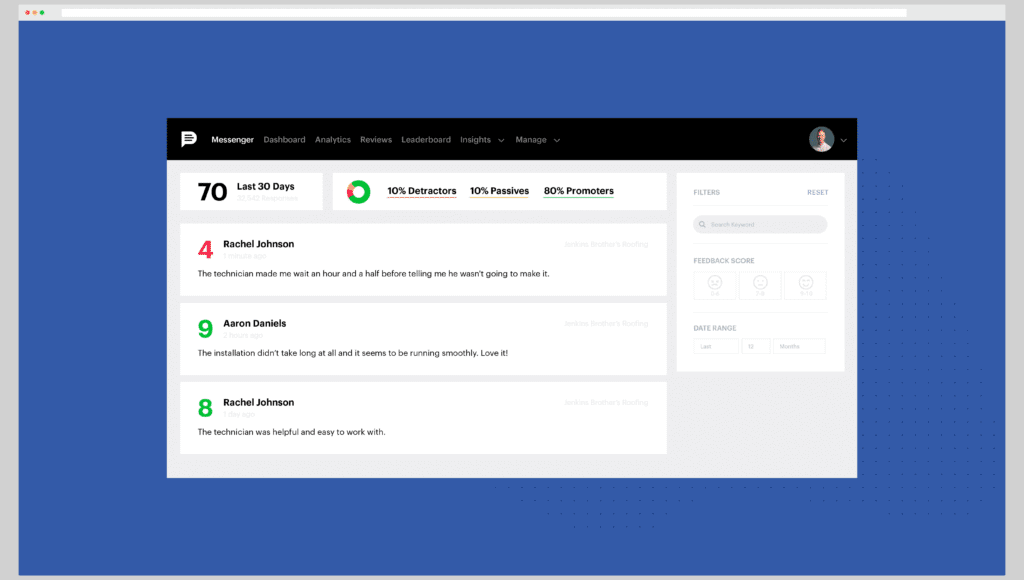
Unlike FeedBear, Podium is specifically a survey tool. Surveys are a great way to get some specific feedback from users, and help you to get insight on how they feel about particular ideas and features that you’re working on.
Podium makes it simple. You add questions, templated or custom, and Podium sends them out through automated messages. You can get contextual information to understand the specific user, and have two-way conversations to follow up on and resolve reported issues.
Podium also gives you scheduling tools, analytics, and other helpful features.
As a survey tool, Podium is really good. As a complete feedback management tool, it’s limited. It’s great for firing off some quick questions to gauge sentiment - but that’s it. Users can’t spontaneously submit their own ideas or comments, and they can’t interact with one another either.
You can achieve the same result with FeedBear by submitting your own ideas to the feedback board and tagging them with “needs your opinion”. FeedBear also gives you a much more versatile set of tools with the Roadmap and Changelog, and facilitates more diverse conversations between all stakeholders.
Using FeedBear in conjunction with Podium could be a good idea, but if you want a single tool with the most bang for your buck, we’d suggest FeedBear.
Pricing: Podium gives custom quotes based on the volume of surveys you want to send
Verdict: A good survey tool but needs to be used in conjunction with other tools to create a real feedback loop
4. Qualaroo

Qualaroo is another survey tool. Unlike Podium though it deploys popups in your site or app to get the feedback. It also has tools for getting feedback on user experience and conversions.
It’s good because it allows you to ask questions contextually at the right moment in the experience, and find out what people think of your website or app while they are using it.
For example you can ask someone why they abandoned their cart or what they think of the pricing while they are looking at it.
Another cool feature of Qualroo is the AI powered sentiment analysis.
Pricing: pricing is per tracked pageview, for 100k pageviews it’ll be $80/m
Verdict: we can see this being particularly useful for eCommerce and UX research. A good tool, but not a complete feedback system.
5. Bazaarvoice
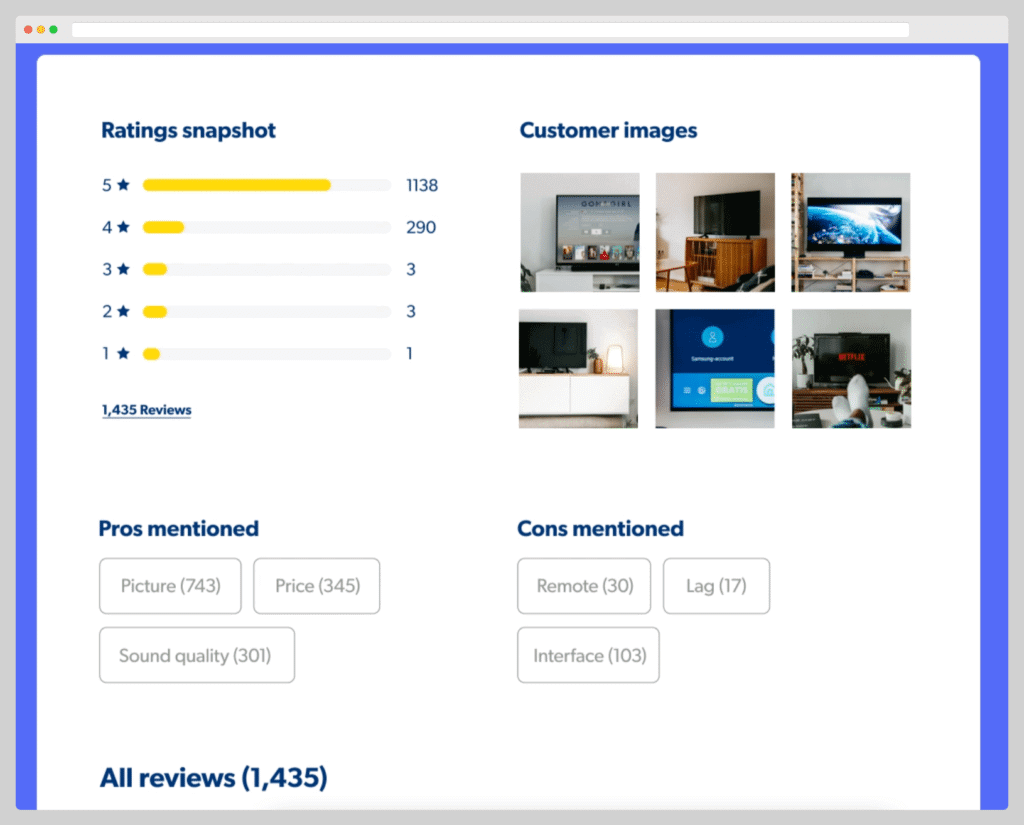
Bazaarvoice is a great feedback tool for eCommerce. It isn’t the same as others in the list though, as its primary purpose is not to gather private feedback. Rather, it's for creating user-generated content like reviews, ratings and product photos.
UGC is all-important for eCommerce, and Bazaarvoice helps you to generate it at scale. They claim that with multi-product submission forms they can help you to gather 10x more reviews, and also display them to other potential customers in the most effective way.
Bazaarvoice is well respected and often recommended in the eCommerce world, so we suggest it as the best option for eCommerce stores that want more reviews, ratings and UGC!
Pricing: Custom plans
Verdict: The best option for eCommerce UGC
6. FeedBackify
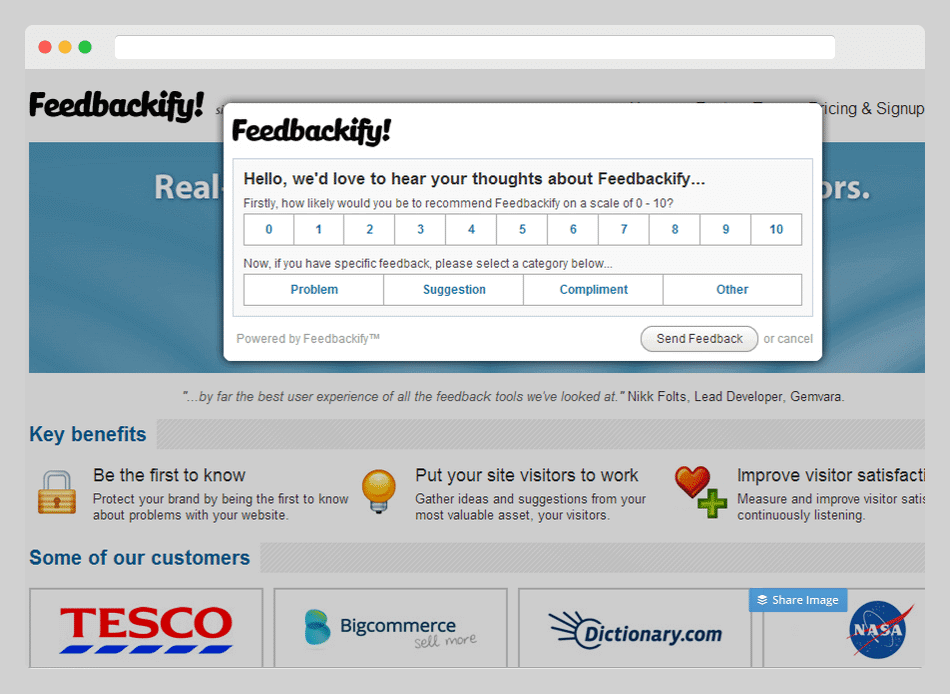
Feedbackify is more toward the corporate, enterprise end of Feedback tools. It is used by household names like Tescos, NASA, Hubspot and many others. At the same time, it’s one of the simplest tools that we’re going to look at.
Essentially, Feedbackify lets you create custom feedback forms, then embed them in your site. You’ll create the forms using a drag and drop editor, then create a feedback tab for your website.
The platform gives you data to understand specific pieces of feedback, like geolocation, browser and point in the user journey. You can also filter feedback by category and subcategory to understand more.
Pricing: $19/m
Verdict: affordable, good option for taking basic feedback. Not as powerful or comprehensive as tools like FeedBear, but decent for “customer service” style feedback management. Not ideal for apps or startups.
7. UserVoice

UserVoice is one of the oldest feedback tools on the market, and has a lot of features. It is used by a lot of huge companies, as it's mainly targeted at the enterprise market.
The onboarding process is known to be a little complex, needing multiple calls with sales representatives and technicians to get set up. The huge range of features can be a challenge to configure.
That said, it is a really powerful tool - and if you need a dizzying array of analytics tools to manage a large volume of user queries and feedback it might be for you and worth the cost.
Pricing: custom plans that start at around $15,000 per year. This is an expensive product.
Verdict: overkill for the majority of startups and SaaS businesses. Might be best for large companies with a huge amount of data to sift through.
8. Typeform

Typeform is a well known form-builder that is often used as a feedback tool. You use a drag-and-drop builder to create the form and can add questions from a variety of types like: multiple choice, rating, opinion, free-form text and more.
It integrates easily with your site, and has a ton of integrations with other tools like Sheets, Salesforce, Zapier, Slack and more.
If you want a basic, simple tool that lets you ask specific questions at certain points of the user’s experience - Typeform is a solid option. It’s not good for having a two-way discussion with users really, or creating any kind of community around your product, but that’s not its intention.
Pricing: there is a free plan, but to use more powerful, interactive forms you’ll need the Professional plan at $50/m or Premium at $70/m.
Verdict: a good option if you just want answers to specific questions and some data you can use to make UX and product decisions. Not so good for surfacing new ideas or as a full feedback system.
9. HotJar
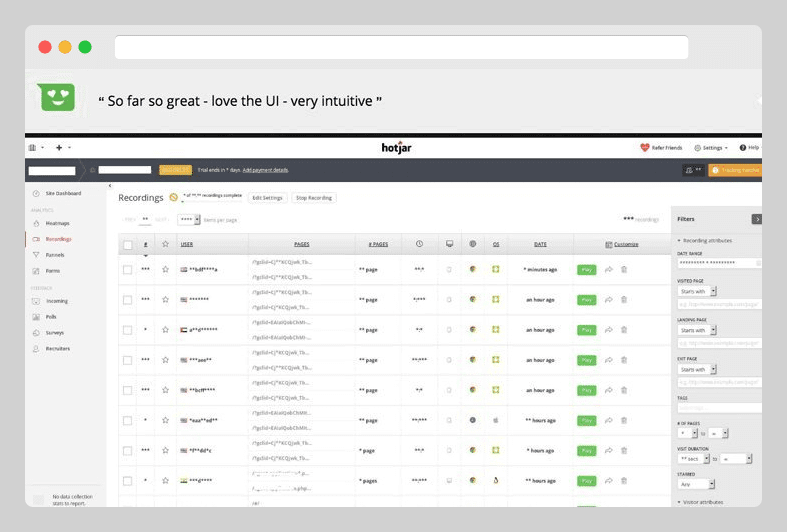
HotJar is a popular solution that works well as a feedback tool. It lets you get granular with the specific visitors you target and the questions that you ask them.
It’s great for user research, and answering specific questions like diagnosing conversion problems or bottlenecks in the user journey. For example HotJar is often used to send surveys at point-of-conversion to figure out what stopped customers from going through with the purchase.
Hotjar is often used to create website and in-app pop ups for surveys and polls. You also get a website feedback widget that can prompt users to give more spontaneous feedback and additional context on their experience.
You get a lot of customization options, and can create a wide range of feedback popups through Hotjar’s dashboard.
Pricing: free plans to get started, $100/m to make use of the best features at moderate scale
Verdict: Probably the best pop-up feedback form tool. Good for user research. Not as good for surfacing new ideas or two-way conversations.
10. Saber
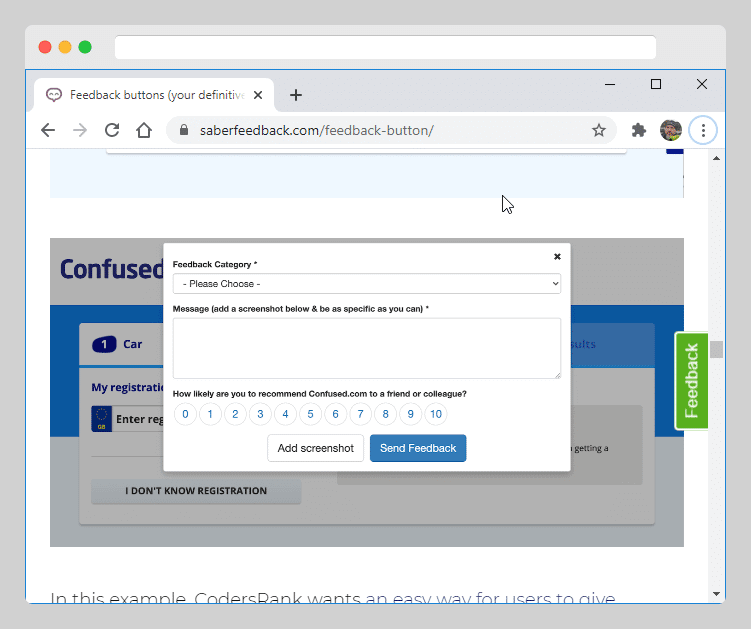
Saber is similar to Feedbackify and also used by several large enterprises. It’s based around customizable forms that you can either build with one of their templates or create from scratch yourself.
You can play around with the logic and flow of the forms, and try out your ideas as real-time previews. You’ll set up a site button, customize it, and select any triggers that will cause it to be hidden or appear.
Saber is particularly good for bug reports. Users can easily screenshot specific elements or content by selecting the chunk they want to screenshot. You’ll get additional information about the user’s OS, setup, Javascript errors and other useful information.
Other useful features of Saber are the ability to export to CSV, getting feedback automatically emailed to you - and handy integrations with Trello, Slack and others.
Pricing: from $29/m for basic features, $59/m to really make use of the key features
Verdict: a good tool for bug reporting, general site feedback and creating forms. Again, let down by the lack of two-way, public interaction.
11. Usersnap

Usersnap is a versatile feedback tool targeted primarily at SaaS businesses. Like many others we’ve covered, you’ll get feedback widgets for your site and a dashboard to create different kinds of widget and process the results.
You can create a feedback menu so that users can browse different feedback sections to find what they want, link to your service chat, and create detailed customer satisfaction surveys to give you and your team valuable insights.
Another cool thing about usersnap is the “micro feedback” feature that lets users give a quick thumbs up or thumbs down to reduce friction and get more data.
Usersnap has tools for getting both qualitative and quantitative feedback, a dashboard for analyzing results, and lets you follow up with users directly from the feedback dashboard. Overall, a nice tool!
Pricing: the lowest plan is only $9/m, but only gives you one feedback project. To run multiple projects, with multiple team members - will cost $69/m on the Startup plan or $129/m on the Company plan.
Verdict: a great tool for measuring customer satisfaction with useful widgets. Falls short of a full feedback system though.
Which Feedback tool should you choose?
We’ve covered 10 of the best feedback tools in 2026. Now it’s time for you to choose which one works best for your business. Here are our overall recommendations.
FeedBear: the best all round feedback tool
We have to put Feedbear at #1 for a few reasons.
- Feedbear is a total feedback system, that encourages the submission of new ideas and interactions between users themselves, team members, and other stakeholders
- FeedBear gives you a site widget, a feedback board, a roadmap, and a changelog. It’s a complete product management tool that has a focus on user feedback.
- FeedBear is great value for money, at $29/m for unlimited features, seats and users.
For an all-purpose feedback system that creates an end-to-end feedback loop, FeedBear is hard to beat. It’s particularly useful for SaaS companies and tech startups!
Typeform: the best form-based feedback tool
If you want to simply ask specific questions to users through forms, Typeform is one of the most full-featured and reliable options. It won’t create a complete feedback system, it will just be one input into the product development stack - but it serves its purpose very well.
HotJar: the best feedback tool for CRO
Hotjar is great for improving conversions and site experience. The ability to get really granular with user context and behavior, to create a wide range of surveys and polls, and to crunch the data with useful tools makes it a great option for CRO specialists.
BazaarVoice : the best eCommerce feedback tool
User generated content is huge in eCommerce. More reviews, ratings, and product photos boost social proof around your offer and are guaranteed to have a positive impact on sales and conversions. BazaarVoice is great for boosting this, and is a solid choice for an eCommerce feedback tool.
Wrapping up
Hopefully this article gave you some useful ideas about which feedback tool is for you. We tried to choose the 10 best on the market and give an objective overview of their pros and cons.
If you want to check out more tools, we also wrote articles about the best changelog tools and the best roadmap tools.
Good luck choosing the right one for you! Making users feel heard, getting their first-hand opinions on your product, and in general taking a user-centric approach has never been more key to success!
FAQs
Convert your website into a mobile app












